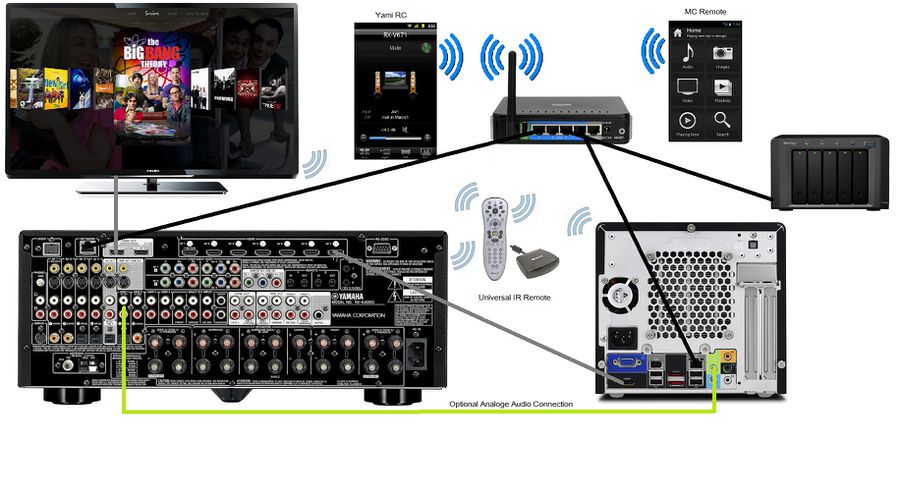Home Networking Examples
Overview
The following are some examples of how users have configured their home networks using MC and other devices.
Example 1 : MC Server computer connected to living room TV, MC client computer connected to projector in family room
I have a Windows 7 server computer in a closet near our living room plasma TV. I run DVI video to the TV and simple analog audio to a Logitech 2.1 speaker system near the TV. The server computer has a large internal drive dedicated to media including recorded TV. The media drive is shared on the home LAN. Media Center is installed on the server computer with media networking fully enabled.
I have another Windows 7 computer in our family room running Media Center as a Library Server client to the living room computer. I run DVI video to a 20" monitor and HDMI video to a 720p projector and digital audio via coax to a Sony A/V amplifier (5.1 speaker system). I also run analog audio to a headphone jack on an exercise treadmill.
I use JRiver MCE remotes and transceivers on each system for remote control.
The setup of the client went pretty smoothly, but there were a few tips that I'll list here for future reference:
- As of build 17.0.63, playback of Blu-ray titles over Library Server is not supported. The work around is to make the filenames on the server match the filenames on the client so that the client will play them using a network drive path or a UNC path rather than over a Library Server URL.
- I programmed a button on the JRiver remote to toggle between the Projector and the monitor as the sole display. There were numerous problems with trying to use an "extend desktop onto both monitors" type of setup so it's preferred to use one monitor at a time. In Tools/Options/Remote Control/Commands, select Add/Custom..., change the name to "Monitor Toggle", and click "Add Run", then type "mc17.exe" for executable filename and "/MonitorToggle" for parameters. Click Ok back to the command list and then with the newly created command highlighted, click "Start Learning" and point your JRiver remote at the transceiver and click the button you want to use (I used the "1" button). Click Ok and you can test it out - press "1" and it should switch to one of the monitors, click "1" again and it should switch to the other monitor. Create another command called "Monitor Extend" with "/MonitorExtend" as the parameter, program it to the "2" button, then you can press "2" to get the desktop extended onto both monitors.
- I setup one zone called ("Headphones") to play through the headphones at the treadmill, and another zone called "Sony Amp" to play through the Sony 5.1 receiver. I then programmed two buttons on the remote to select those zones. On the remote control command list screen, use Add/Add Media Center Command. Select the zone you want for each button, then train those buttons (I used buttons "3" and "4") using the "Start Learning" process described in the previous tip. I documented these remote buttons and taped the piece of paper to the treadmill stand.
- In Tools/Options/Theater View, I set these options:
- Check "Disable screen saver in Theater View"
- Check "Disable Windows Media Center"
- Set "Switch to zone on load" to "Sony Amp" since we use that more often than the treadmill headphones.
- In Tools/Options/Startup, I set these options:
- Set "Location" to "Last Location"
- Set "Mode" to "Theater View"
- Set "Run on Windows startup" to "Media Server" so that all it ever takes to get into Theater View is to press the green button on the remote.
- In Tools/Options/Media Network, I set these options:
- Un-check "Client Options/Show playback zones from server on the client" because I didn't want to allow the "There" zone to be selected for playback on the server.
- In Tools/Options/Remote Control, I set these options:
- Click "Devices & Options", make sure "Selected input devices" contains both "Microsoft MCE" and "Remote, keyboard, gamepad, or other HID" as active.
Example 2 : Typical Home Network Setup with an AVR and HTPC and NAS
Here is a crude pic showing a setup using a HTPC connected to a AVR and pulling the media from a NAS over a home network. 1) Connect the HTPC, NAS, Yami etc up on using Ethernet if you can (most reliable) 2) Use the Wireless connection for your Remote Android/iPhone Apps 3) Use a universal IR RC to control the HTPC/Yami/TV 4) User HDMI between the HTPC >> Yami >> TV 5) Optionally add the Analogue Audio Cable to enable a second Audio Zone.
